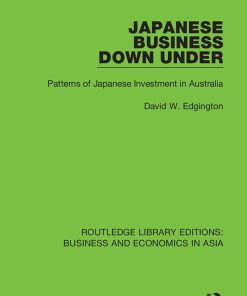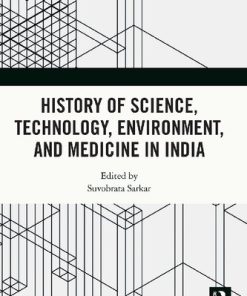Science Technology and Medicine in the Modern Japanese Empire 1st Edition by David G Wittner, Philip C Brown ISBN 9781138905337 113890533X
$50.00 Original price was: $50.00.$25.00Current price is: $25.00.
Science Technology and Medicine in the Modern Japanese Empire 1st Edition by David G Wittner, Philip C Brown – Ebook PDF Instant Download/Delivery: 9781138905337 ,113890533X
Full download Science Technology and Medicine in the Modern Japanese Empire 1st Edition after payment

Product details:
ISBN 10: 113890533X
ISBN 13: 9781138905337
Author: David G Wittner, Philip C Brown
Science Technology and Medicine in the Modern Japanese Empire 1st Edition Table of contents:
1 On science and faith in the life of a Meiji engineer
Introduction
The school and the congregation
The Kumamoto School for Western Learning: catching up with the Restoration
Jesus the magician: conversion and misunderstanding
Fighting against scientific atheism: the making of a Christian scientist?
Theory and practice: from science teacher to chemical industry
Working pressure
The Religion of Jesus, spirits, and reincarnation
Conclusion
Notes
2 Academia–industry relations Interpreting the role of Nagai Nagayoshi in the development of new businesses in the Meiji period and beyond
Introduction
Nagai’s Meiji period industry role: Dainippon Seiyaku
New businesses in the Taishō period: Naikoku Pharmaceutical Company
Technological innovation at local businesses: the case of the Awa indigo business
Industry–academia ties in Tokushima prefecture: Tomita Pharmaceutical Company
Conclusions
Notes
3 An emperor’s chemist in war and peace Sakurai Jōji during the Russo-Japanese War and World War I
Introduction
Nationalism/patriotism echoed: Sakurai and William Ramsay at University College London
Turning point: Sakurai during the Russo-Japanese War
Sakurai during the First World War
Conclusions
Notes
4 Buddhism contra cholera How the Meiji state recruited religion against epidemic disease
Introduction
A peculiar publication
Cholera in Japan to 1880
Cultural reflections of cholera
Text and context of Korera yobō no satoshi
Conclusion
Notes
5 The influenza pandemic of 1918, Taishō Democracy and freedom of the press during the Siberian Intervention
The 1918 pandemic
Taishō Democracy, the Osaka Asahi and the growth of press censorship
Censorship, influenzas, and the Siberian Intervention
Limited censorship: Taishō Democracy or special circumstances?
Acknowledgements
Notes
6 The politics of manic depression in the Japanese empire
Manic depression and degeneration
Manic depression, character, and crime
Manic depression and civilized status
Manic depression, climate, and Nanshin policy
Conclusion
Notes
7 A colony or a sanitarium? A comparative history of segregation politics of Hansen’s disease in modern Japan
Introduction
Legislation on the treatment of Hansen’s disease sufferers in prewar and wartime Japan
Two proposed plans for the treatment of Hansen’s disease sufferers
A free area for Hansen’s sufferers had already appeared
Two plans by the Sanitation Investigation Council in 1920 and their consequences
Conclusion
Notes
8 “They are not human” Hansen’s disease and medical responses to Hōjō Tamio1
Introduction
The colonial encounter with Hansen’s disease in Japan
Doctors reading Hōjō Tamio
Patient experience in “Life’s First Night”
Conclusion
Notes
9 Dr. Baelz’s Mongolian spot German medicine, discourse of race in Meiji Japan, and the local response
Baelz’s integrative perspective on the Japanese “race”
German medicine and the question of race in Japan
The Japanese reaction and Baelz’s racial legacy
Notes
10 When precision obscures Disease categories related to cholera during the Sino-Japanese War (1894–1895)
Introduction
The Japanese
Cholera during the war
Quarantine efforts
Conclusion
Notes
11 Kampō in wartime Sino-Japanese relations The Association of East Asian Medicine and the search for a tripartite medical partnership
The Association of East Asian Medicine and tripartite medical partnership
Programs and activities for a tripartite partnership
Limitations and frustration in the wartime search for a tripartite partnership
Conclusion
Notes
12 The question of research in prewar Japanese physics
Introduction
Kitao Diro (Jirō) and local science
Nagaoka and the Japanese capability for research
Nakamura Seiji on the Imperial Institute for Physical Research and RIKEN
Terada Torahiko and experimental physics
Ishiwara Jun and modern physics
Nishina Yoshio and atomic physics in Japan
Yukawa Hideki and Tomonaga Sin-itiro
Conclusion
Notes
13 Architects of ABC weapons for the Japanese empire Microbiologists and theoretical physicists
Introduction
A case of biological and chemical weapons development
Atomic weapons development
Conclusion
Notes
14 The science of population and birth control in post-war Japan
Introduction
The “population problem” and the state birth control campaign in the immediate post-war period
Birth control in public health, Japanese demography, and American population controllers
Conclusion
Acknowledgement
Notes
Afterword: Is there anything unique about modern Japanese science?
Case studies: Yamagiwa Katsusaburō and Yukawa Hideki
Uniqueness, particularity, and culture
Yamagiwa Katsusaburō and the founding of chemical carcinogenesis
Yukawa Hideki, Buddhism, Confucianism, and quantum physics
Conclusion
Notes
Bibliography
Archives
Newspapers
Primary and archival sources
People also search for Science Technology and Medicine in the Modern Japanese Empire 1st Edition:
consortium for history of science technology and medicine
history of science technology and medicine in india
east asian science technology and medicine
centre for the history of science technology and medicine
clinical science technology and medicine summer internship
Tags: David G Wittner, Philip C Brown, Science Technology, Modern Japanese Empire
You may also like…
History - Military History
Business & Economics - Responsibility and Business Ethics
Japanese Business Down under Patterns of Japanese Investment in Australia David W. Edgington
Uncategorized
The Japanese and Western Science 1st edition by Masao Watanabe 0812282523 9780812282528
Business & Economics
The Japanese Economy 4th Edition by David Flath ISBN 9780192688880 019268888X
Uncategorized
Engineering - Chemical Engineering
Latex Dipping Science and Technology 2nd Edition David M. Hill
Uncategorized
Politics & Philosophy - Government & Politics










